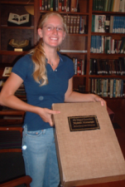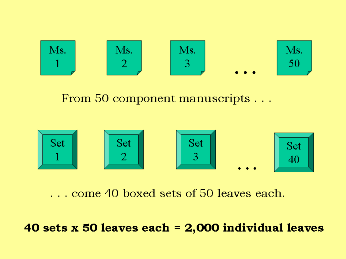"Fifty Original Leaves from Medieval Manuscripts"

Greta Smith with a portfolio.
Ege’s biblioclasty, however ethically problematic it may be, has resulted in the presence of a considerable number of manuscript and printed leaves being dispersed around the world. These leaves are immensely valuable to undergraduate education, and can provide a good initial training ground for advanced scholarly work. They are also, insofar as they exist in these specimen sets, fairly traceable, and this small but important point allows us to begin the long process of tracking them down and collating them as a unified phenomenon; therefore the first phase of Ege scholarship (as demonstrated by this website, for example) has focused on the challenges of bibliography and provenance posed by the separating and dispersing of the component parts of the final commercial set listed on the previous page: the celebrated Fifty Original Leaves from Medieval Manuscripts. Western Europe: XII-XVI Century.

At some point during or just after the second World War, Professor Ege selected 50 of his own fragmentary manuscripts dating to between 1100 and 1600 and removed a leaf from each one; he then arranged those leaves into a boxed set. He did this forty times—thus creating forty sets of 50 leaves each. All forty of the sets are both similar to and different from one another—each of them contains different pages from the same 50 component manuscripts, and the overall scope of this particular leaf-book project was thus 2,000 leaves. The leaves were then mounted onto large (about 1¾ x 2½ feet) heavy bond paper window folders, and a card containing a general description of the type of manuscript and its decorative style was attached. The framed leaves were placed in generally chronological order inside large tan buckram-covered board portfolio boxes, numbered, and prefixed by a simple master list of the leaves which explains the project thus:

"These fifty manuscript leaves were selected to illustrate the art of the manuscript during the period of its greatest development and influence. They have been taken from books written in various European scriptoria by Benedictine, Franciscan, Carthusian, Dominican, and other orders of monks. Many are enriched with handsome borders, initial letters, and line-endings rendered in color, and twenty-five are illuminated with burnished gold or silver. The texts include the Bible, various church service books, the writings of the Church Fathers, and some of the classics.
"Changes in book hands from the revised carolingian to the angular and round gothic, the bâtarde, and humanistic style of writing are illustrated. Tools, materials, and their use and preparation are described, and some methods of dating and allocating the provenance of the book from which the leaf was taken are pointed out in the label attached to each of the leaves.
"The leaves were accumulated and selected and
all of the accompanying information was prepared over a period of forty
years by the late Otto F. Ege, Dean of the Cleveland Institute of Art
and Lecturer on History of the Book at the School of Library Science,
Western Reserve University."
The fifty component manuscripts (and the forty sets they were made into) were selected by Ege to represent the variety of common types of medieval religious manuscripts, both personal and service-oriented—Bibles, Psalters, missals, hymnals, Books of Hours, breviaries, and so on—as well as less common forms such as an Aurora. Here are the descriptions Ege himself offered for the contents:
- Switzerland (?): New Testament (Testamentum Novum, cum Glossis Bedae, Hieronymi, et Gregorii). Early 12th C. Latin text; Revived Carolingian script.
- Spain (or Southern France): Missal (Missale Plenarium). Middle 12th C. Latin text; Revived Carolingian script.
- Italy: Lectionary: Middle 12th C. Latin text; Revived Carolingian script.
- France: Psalter. Late 12th C. Latin text; Caroline Minuscule.
- France: Bible. Early 13th C. Latin text; early Angular Gothic script.
- England (Cambridge): Cambridge Bible. Early 13th C. Latin text; early Angular Gothic script.
- England: Aurora. Early 13th C. Latin text; early Gothic Script.
- England: Gradual. Early 13th C. Latin text; early Angular Gothic script; square Gregorian notation.
- France (Paris): Bible. Middle 13th C. Latin text; Minuscule Angular Gothic script.
- Germany: Psalter. Illuminated. Middle 13th C. Latin text; Angular Gothic script.
- Italy: Bible. Middle 13th C. Latin text; Rotunda Gothic script.
- France: Psalter. Illuminated. Middle 13th C. Latin text; Angular Gothic script.
- England (Oxford): Oxford Bible. Middle 13th C. Latin text; Angular Gothic script.
- France: Bible. Illuminated. Late 13th C. Latin text; Angular Gothic script.
- France (Beauvais): Missal (Missale bellovacense). Illuminated. Late 13th C. Latin text; Transitional Gothic script.
- France: Breviary. Illuminated. Late 13th C. Latin text; Angular Gothic script.
- England: Psalter. Illuminated. Late 13th C. Latin text; Angular Gothic script.
- France: Breviary. Late 13th C. Latin text; Angular Gothic script.
- Italy: Vulgate Bible. Illuminated. Early 14th C. Latin text; Transitional Rotunda script.
- Netherlands: Psalter. Illuminated. Early 14th C. Latin text; Angular Gothic script.
- France: Hymnal. Illuminated. Early 14th C. Latin text; Angular Gothic script; Gregorian notation.
- Germany (Würzburg): Missal (Missale Herbipolense). Early 14th C. Latin text; Gothic script; transitional Early Gothic notation.
- France: Breviary. Illuminated. Middle 14th C. Latin text; Angular Gothic script.
- England: Book of Hours. Illuminated. Middle 14th C. Latin text; Angular Gothic script.
- Germany: Psalter. Illuminated. Late 14th C. Latin text; Gothic script.
- France (Rouen): Missal. Illuminated. Late 14th C. Latin text; Angular Gothic script.
- Italy: Antiphonal. Early 15th C. Latin text; Rotunda Gothic script; Gregorian notation.
- Northern France: Book of Hours. Illuminated. Middle 15th C. Latin text; Angular Gothic script.
- France: Book of Hours. Illuminated. Middle 15th C. Latin text; Angular Gothic script.
- France: Book of Hours. Middle 15th C. Latin text; Angular Gothic script.
- France: Book of Hours. Middle 15th C. Latin text; Angular Gothic script.
- Italy (Florence): Gradual. Illuminated. Middle 15th C. Latin text; Rotunda Gothic script; square notations.
- Germany: Missal. Middle 15th C. Latin text; Angular Gothic script.
- Italy: Psalter. Middle 15th C. Latin text; Rotunda Book Hand; square notations.
- France: Writings of St. Jerome (Sanctus Hieronymus, Contra Jovinianum). Middle 15th C. Latin text; Lettre de Somme.
- France: Book of Hours. Illuminated. Middle 15th C. Latin text; Angular Gothic script.
- Italy: Epistolary. Middle 15th C. Latin text; Rotunda or Round Gothic script; square rhetorical neumes.
- France (Limoges): Missal (Missale Lemovicense Castrense). Middle 15th C. Latin text; Angular Gothic script.
- Italy: Livy’s History of Rome (T. Livii ab Urbe Condita Libri). Middle 15th C. Latin text; Humanist script.
- Italy: Thomas Aquinas, Commentary on the Sentences (Super Primo Libro Sententiarum). Late 15th C. Latin text; Humanist Book Hand.
- France: Dialogues of Gregory the Great (S. Gregorius Magnus, Dialogi). Late 15th C. Latin text; Lettre Bâtarde.
- Germany (Würzburg): Psalter. Late 15th C. Latin text; Angular Gothic script; Gothic notation.
- Netherlands: Book of Hours. Late 15th C. Latin text; Bold Angular Gothic script.
- Germany: Bible. Late 15th C. Latin text; Semi-Gothic script.
- France: Book of Hours. Illuminated. Late 15th C. Latin text; Gothic script.
- Northern France: Book of Hours. Illuminated. Late 15th C. Latin text; Gothic script.
- Netherlands: Book of Hours. Illuminated. Late 15th C. Latin text; Angular Gothic script.
- Netherlands: Book of Hours. Illuminated. Late 15th C. Latin text; Lettre de Forme.
- Germany: Missal. Early 16th C. Latin text; Lettre Bâtarde.
- France: Book of Hours. Illuminated. Early 16th C. Latin text; Cursive Gothic script.

A few of the more unusual items here are numbers 39-41, 15th-century copies of Livy’s History of Rome, Aquinas’ Commentary on the Sentences of Peter Lombard, and the Dialogues of Gregory the Great (the provenance and quality of the Livy in particular makes it a noteworthy inclusion), and number 15, the breathtaking Beauvais Missal.
The above is a list of the component manuscripts as Ege identified them: I gently emphasize the latter phrase, since any detailed engagement with the sets will cause a contemporary student of medieval handwriting and decoration to dispute many of Ege’s identifications. Still, the original numbering system and general descriptions (which may or may not be identical in all portfolios) do provide a consistent frame of reference at this time, and amply demonstrate the breadth of the contents of the forty portfolios.